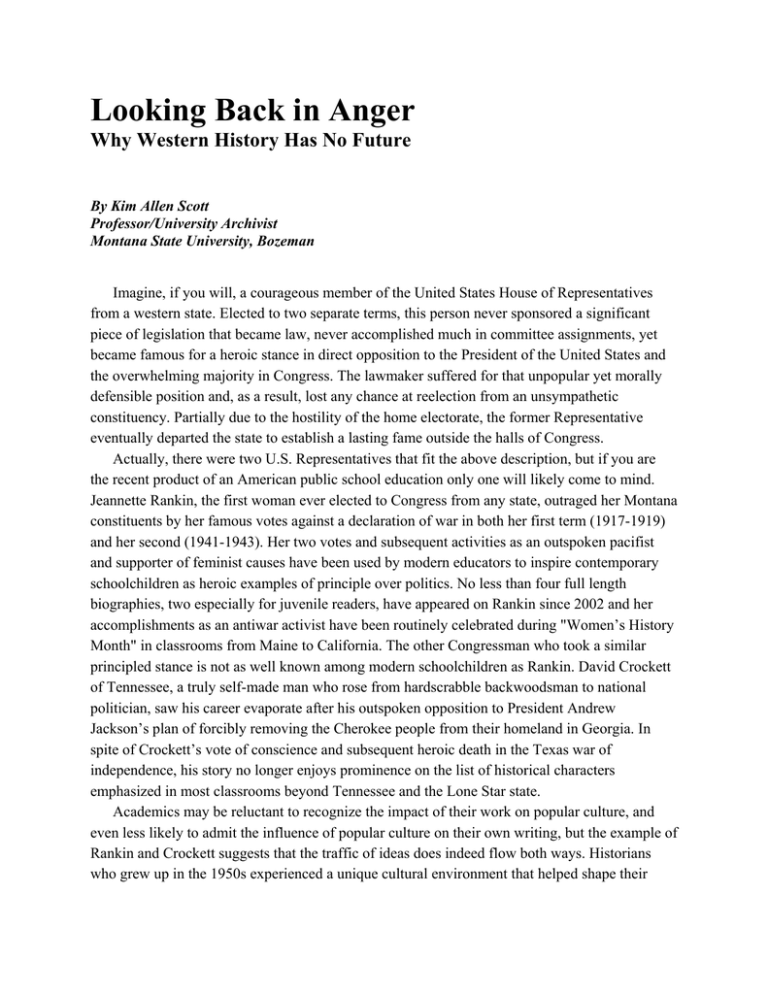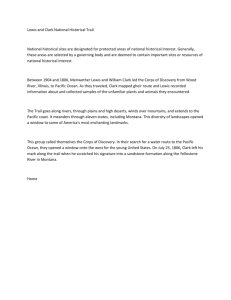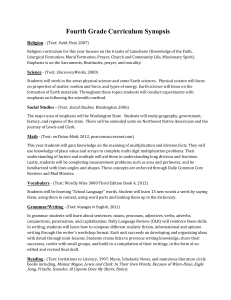Looking Back in Anger Why Western History Has No Future
advertisement

Looking Back in Anger Why Western History Has No Future By Kim Allen Scott Professor/University Archivist Montana State University, Bozeman Imagine, if you will, a courageous member of the United States House of Representatives from a western state. Elected to two separate terms, this person never sponsored a significant piece of legislation that became law, never accomplished much in committee assignments, yet became famous for a heroic stance in direct opposition to the President of the United States and the overwhelming majority in Congress. The lawmaker suffered for that unpopular yet morally defensible position and, as a result, lost any chance at reelection from an unsympathetic constituency. Partially due to the hostility of the home electorate, the former Representative eventually departed the state to establish a lasting fame outside the halls of Congress. Actually, there were two U.S. Representatives that fit the above description, but if you are the recent product of an American public school education only one will likely come to mind. Jeannette Rankin, the first woman ever elected to Congress from any state, outraged her Montana constituents by her famous votes against a declaration of war in both her first term (1917-1919) and her second (1941-1943). Her two votes and subsequent activities as an outspoken pacifist and supporter of feminist causes have been used by modern educators to inspire contemporary schoolchildren as heroic examples of principle over politics. No less than four full length biographies, two especially for juvenile readers, have appeared on Rankin since 2002 and her accomplishments as an antiwar activist have been routinely celebrated during "Women’s History Month" in classrooms from Maine to California. The other Congressman who took a similar principled stance is not as well known among modern schoolchildren as Rankin. David Crockett of Tennessee, a truly self-made man who rose from hardscrabble backwoodsman to national politician, saw his career evaporate after his outspoken opposition to President Andrew Jackson’s plan of forcibly removing the Cherokee people from their homeland in Georgia. In spite of Crockett’s vote of conscience and subsequent heroic death in the Texas war of independence, his story no longer enjoys prominence on the list of historical characters emphasized in most classrooms beyond Tennessee and the Lone Star state. Academics may be reluctant to recognize the impact of their work on popular culture, and even less likely to admit the influence of popular culture on their own writing, but the example of Rankin and Crockett suggests that the traffic of ideas does indeed flow both ways. Historians who grew up in the 1950s experienced a unique cultural environment that helped shape their future intellectual inquiries, and yet the product of their adult research has helped achieve a widespread dismissal of the western story in American popular culture. The traditional celebratory narrative has given way to more realistic interpretations by adopting a critical and, I would argue, peculiarly angry tone. The results of this shift of interpretation over recent decades are obvious and suggest a dismal future for public interest in western history, both in its popular culture manifestations and its practice as an academic discipline. Indeed, to a casual observer, it seems to be a history without a future. One beautiful Saturday afternoon in February, 2004, I visited Tombstone, Arizona with my older brother who was assisting me in some field research. Having grown up in Tucson during the 1960s, my family early established a tradition of attending Tombstone’s "Helldorado Days" celebration every October, and my brother and I wanted to see how much the little town had changed during the past forty years. We were happily surprised to find it much the same, with long board sidewalks fronting Old West-style souvenir shops and drinking establishments. As we strolled along Allen Street taking in the view, however, we both began to realize something had, indeed, changed. Here, at the end of southern Arizona’s winter tourist season, the streets were devoid of children and what few tourists we could see wore black leather motorcycle togs and were quite grayhaired. In fact, I believe from our three hour visit my brother and I, both in our early fifties, were among the youngest people I saw visiting the streets of Tombstone that afternoon. Demographers have labeled Americans born between 1947 and 1962 as "baby boomers" and as one of their number I was exposed to a unique set of social conditions that the other generations have lacked. During my childhood and that of the greybearded bikers we saw swaggering around Tombstone that afternoon, Americans enthusiastically embraced the western story in popular culture. Westerns enjoyed a new surge of popularity in the 1950s just as television began to change American’s leisure time preferences, bringing the serialized B-movie westerns of the 1930s to an entirely new audience and spawning a host of shows especially created to meet an increasing demand. By 1959 twenty-six weekly programs airing during prime time were westerns1 and baby boomers became so inundated with the genre that the standard small screen depiction of anyone watching television in those years always included the sounds of thundering hooves and sporadic gunfire. Interest in western history was fueled by its reenforcement in print during this period as well, with a steady stream of celebratory histories, genre magazines, and paperback fiction books. By the mid 1960s when the first baby boomers started college, their interest in the western story collided with current events that helped foster a more realistic, yet darker interpretation of the nation’s frontier experience. Those young adults who had enjoyed "Gunsmoke" and "Rawhide" as children began to examine western history in classes taught concurrently with the civil rights movement, the Viet Nam war, and a growing environmental sensitivity in America. A childhood embrace of simple hero tales that led many to the study of western history gave way to a cynical conclusion that Americans had been purposely lied to by celebratory narratives and Hollywood movies. Ph.D. candidates took their critical outlook on contemporary American culture and applied a combination of cliometrics and social critique to emphasize a more inclusive interpretation of the nation’s historical record. The resulting body of work produced had at least one common element; a sense that American history in general, and the frontier experience in particular, is certainly nothing to blindly celebrate. In their meticulous dissection of western history, revisionist histories implied that the accomplishments of previously ignored participants had been purposely concealed by a culture that acquiesced discrimination based on race, gender and class. By rejecting the old celebratory interpretations, academic researchers found contemporary outrages to merge with familiar stories. Our record of botched relations with Native Americans found a convenient parallel in our treatment of other races in southeast Asia, and General George Custer easily morphed into a early version of Lieutenant William Calley. The colorful stories of miners and cowboys were often painted with a brush that emphasized the environmental degradation that mineral extraction and overgrazing caused. The failure of the "old" western history to acknowledge women’s multifaceted participation in settling the west became in the "new" western history a conspiratorial lie promoted by former writers who were unwilling to emphasize the importance of female contributions to the story of the west. These new interpretations of our past helped establish a perception, reflected by popular culture, that the traditional stories boomers had seen and read while growing up were false as best, and at worst, unhealthy reinforcements to the worst behavior in our society. Movie makers detected and reacted to the attitude shift by producing films that reflected the growing reluctance of Americans to look at the western myth as an escape from an increasingly complex and frightening modern world. The evolution from the celebratory to the shameful in western movies such as Little Big Man and Soldier Blue helped destroy in audiences any suspension of disbelief for the simpler times of the frontier. The western slowly disappeared from our living rooms, too, replaced by a new fantasy of television space explorers and tough cops confronting evil in the frontier of outer space or the back alleys of contemporary cities. Those viewers longing for a world of simple "good guys" versus "bad guy" grew to accept the fantasy if staged in some futuristic world or modern mean streets, but totally resistant to the story if its setting was placed on a sagebrush covered prairie. In all fairness, it should be pointed out that advent of the new western history and the concurrent decline of western movie popularity had been long overdue. With a surfeit of works on the accomplishments of soldiers, cowpunchers and mountain men, the western story had evolved into a one dimensional tale of brave Euro-American males with scant notice of anyone else. However, in attempting to restore balance to an overly simplified fable, revisionists created scholarship which helped replace one myth with another in the popular consciousness. For example, in a 2006 article about the management of Yellowstone National Park, a Bozeman newspaper feature casually remarked that when the Park was occupied by Native Americans it was "open to all" regardless of tribal affiliation, "but then came the grim genocidal campaign to wrest the West from indigenous people."2 Instead of a myth featuring courageous pioneers battling fearsome natives, popular culture has replaced it with a myth of pre-Columbian societies living in harmony with both nature and one another. Our current crop of public school teachers, exposed during their college education to a hypercritical portrayal of our country’s history, have unavoidably passed on to their students the interpretive anger over the real and imagined crimes committed during the settlement of the west. By continually reminding their students about the admittedly bankrupt notion of white male settlers taming a savage frontier, and emphasizing the more pedestrian tales of marginal participants, teachers have influenced children’s natural yearning for hero stories to simply look elsewhere. If maturation of a culture should be marked by a renunciation of fables advocating violence as the first choice of conflict resolution, ours has merely transferred its accepted setting from the dusty streets of Dodge City to the environs of galaxies far, far away. What are the consequences for a subdiscipline of history that enjoys no popular culture reenforcement? The decline of enthusiasm for western history during the past few decades is a topic that few inside or outside the academy seem willing to discuss. This is understandable, since academics and buffs alike have an economic stake in preserving a myopic cognitive dissonance regarding the field’s popularity. However, with younger people convinced that the American western experience is something to be more regretted than celebrated, and academics continuing to churn out articles that reenforce a popular perception of national shame over the conquest of our portion of the continent, is it any wonder that few college students of the present find the history of the American west an engaging topic? If economic arguments are the quickest way to get someone’s attention, our recent observance of the Lewis and Clark bicentennial ought to have been a wakeup call no one could ignore. In 1996, when historian Stephen Ambrose enjoyed widespread success with his book Undaunted Courage, it looked for a moment that elements of the old story had returned. Lewis and Clark in their epic trek across the continent seemed to fit the bill as western heroes for a new generation. Even Ken Burns could not resist the allure of the expedition’s story and produced a well received documentary of the journey in 1997. In the years that followed, though, the popularity of Ambrose’s book and Burns’ film was systematically eroded by those who apparently found the story an uncomfortable reminder of the celebratory history they thought had been eradicated. Even though both the book and the film gave due recognition to the contributions of Sacagawea for the expedition’s success, some historians joined a chorus portraying the intrepid explorers as little more than the harbingers of doom for the native peoples they encountered. This interpretation also influenced how the popular media began to examine the legacy of the Corps of Discovery as the bicentennial approached, with a seemingly endless stream of headlined news releases reminding us that Native Americans found nothing to celebrate in the planned observances.3 The results of this disgruntled look back had concrete economic repercussions. Reenactors attempting to portray the explorers faced angry protest demonstrations along their route, and the expected millions of tourists who event organizers thought would trace the expedition’s journey during the bicentennial failed to appear. Communities along the Missouri River and the further reaches of the northwest lost untold dollars bankrolling "signature events" that few people attended. Piles of merchandise, from Lewis and Clark coloring books to Corps of Discovery keychains, gathered dust alongside rubber tomahawks in gift shops. In fact, only one aspect of observing the Lewis and Clark expedition seemed to make money in the area of Montana where I live. Within a thirty mile radius of Bozeman artists profited by the commission of two statues of Sacagawea during the bicentennial, supplementing no less than two others that had been previously erected in the town itself.4 (It should be noted that within the same geographic region there are no statues of the expedition’s actual leaders. Only a small granite slab in front of Montana State University’s Renne Library that reproduces a page from Captain Clark’s journal specifically commemorates his accomplishment.) In the first decade of the twenty-first century, the Montana State Legislature has continued to debate the wisdom of offering film producers tax breaks to encourage the industry in the state, but the issue begs the question of exactly what sort of films these incentives are supposed to be attracting. Most of the paltry sampling of western movies produced in recent years have been released directly to the rental video market, a sure fire indication that the entertainment industry recognizes the ever-contracting customer niche for their product. The only popular small screen western to appear on any major television network since the turn of the twenty-first century has been HBO’s Deadwood.5 Even if parents had foolishly allowed their children to watch the show does anyone think that the nation’s youth would have rediscovered the genre by witnessing the most vulgar dialogue in broadcasting history? The professional practice of western history today almost seems doomed to the composition of an increasingly esoteric collection of angry compilations that describe a sad record of racism, genocide, and environmental degradation, while popular histories like Undaunted Courage will probably continue to be dismissed as so much fluff. An interesting demonstration of this divide between the newer academic and older popular historians can be seen in the rancorous annual meetings of the Western History Association. Older members of the WHA, some of whom have consistently expressed their support for celebratory narratives, are being replaced by younger academics who embrace what Australians colorfully refer to as "black armband history," a negative interpretation of European expansion at the expense of a fragile landscape and indigenous people. The friction at the WHA’s recent annual meetings has been palpable and the results of a 2005 membership survey suggested a real generational conflict among its members. For public school students, the only potential source for the continuing creation and consumption of western history, the outlook is even more dismal. By inflating the accomplishments of marginal players on the historical stage, ignoring the roles of traditionally celebrated characters, and suggesting that our western expansion was a regrettable experience, schools have helped to wring the last few drops of interest from the dynamic story of our western heritage. Outside of the classroom, American children simply lack any cultural reinforcement to pique their interest in western history as well. As a result, today’s youth have even equated the word "history" itself with something that is obsolete or dead, and redefined the word "cowboy" as a verb referring to independent and reckless action regardless of its consequences. Even academic scholarship helps young people find new meanings for terms such as "frontier," which has been defined as the "f-word . . . jammed with nationalistic self-congratulation and toxic ethnocentrism."6 It seems highly unlikely that the western story will ever enjoy the same popularity in the entertainment world as it did in the 1950s, and the historical studies that have come from baby boomer scholarship have done a thorough job of reinforcing the notion that the old story needed to go. American schoolchildren no longer carry "Hopalong Cassidy" lunch boxes, and today they are much more likely to read Harry Potter than the Adventures of Davy Crockett. Those few who enter college and choose history as a major feel no nostalgic pull for the exciting story of America’s western expansion and, if anything, look upon the field as a collation of regrettable stories that lack interest and inspiration. Perhaps this is as it should be. It is important for any mature culture to have a balanced view of their heritage, and placing the record of our country’s development beyond ill-defined regional subdivisions allows for a continuous academic exercise of reevaluation regarding our national identity. That being said, it must be confessed there is little in the new western history that has quite the punch of the colorful story we used to believe, and many upcoming historians may just decide that western history is no more than a catalog of crimes best overlooked as they build their careers. NOTES 1. Jeff Kisseloff, The Box: An Oral History of Television, 1920-1961 (New York: Penguin Books, 1995): 231. 2. George Ochenksi, "Yellowstone’s Future," Tributary (Bozeman, Mont.) June, 2006, 12. 3. For a few examples see Joseph B. Frazier, "Tribes have different view of Lewis and Clark," Casper Star Tribune, Sunday, October 30, 2005; Robert J. Miller, "Lewis and Clark Helped Rob American Indians," Seattle Post-Intelligencer, Wednesday, January 28, 2004; Margot Roosevelt. "Tribal Culture Clash: Participate, profit or protest? Native Americans are sharply divided on the merits of the bicentennial," Time 160, 2 (July 8, 2002): 66: Lance Morrow, "This Land Is Whose Land? Times and priorities change. Woody Guthrie hailed Lewis and Clark for finding a place to build dams. Today his tune might be different," Time 160, 2 (July 8, 2002): 78. 4. There are more statues of Sacagawea in the United States than any other woman in American history. At Three Forks, Montana, a larger than life statue of Sacagawea was commissioned in 2005 by the Three Forks Area Historical Society. Not to be outdone, the town of Livingston, Montana commissioned another statue in 2006 at their Sacagawea city park, this one depicting the woman mounted on a horse. These sculptures were in addition to one already in place on Bozeman’s major commercial avenue by Pat Mathiesen and another installed in the early 1990s at the Sacagawea Middle School. 5. One interesting exception to this statement has been the successful marketing campaign for the AMC television network’s 2006 high budget western, Broken Trail. The television film was advertised heavily on the small screen as one would expect, but AMC took the unusual step of running trailers for it in movie theaters as well. While this strategy resulted in some of the highest ratings for any cable network show that year, advertising a television show in movie houses can also be interpreted as recognition that the customer base for big budget westerns is not large enough to justify a theatrical release. 6. Patricia Nelson Limerick, "The Adventures of the Frontier in the Twentieth Century," in Richard White, Patricia Nelson Limerick, James R Grossman, and Newberry Library. The Frontier in American Culture: an Exhibition at the Newberry Library, August 26, 1994 - January 7, 1995



